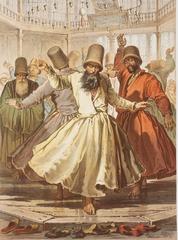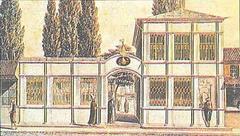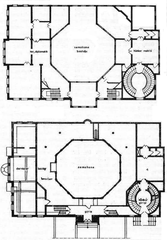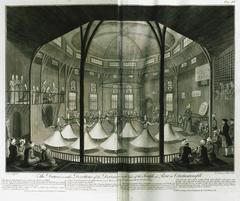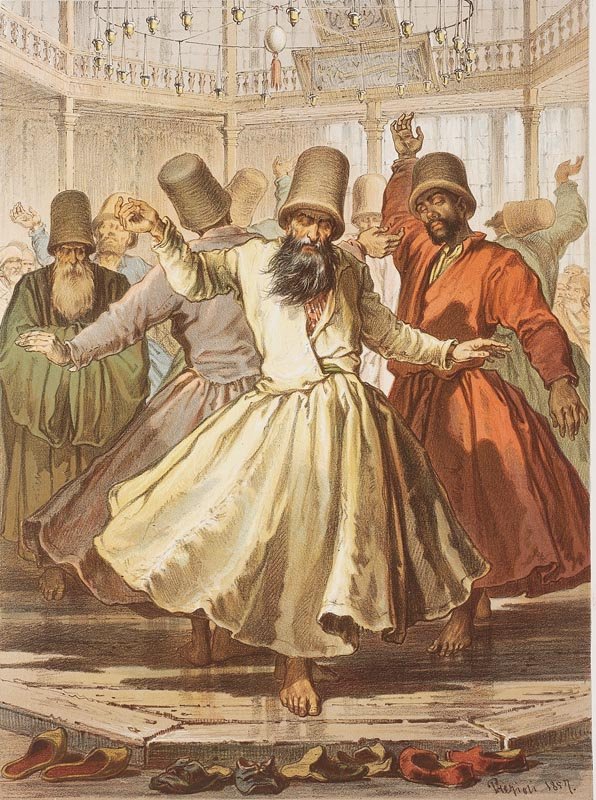
Galata Mevlevihanesi: Visiting Hours, Tickets, and Istanbul Historical Sites Guide
Date: 15/06/2025
Introduction
Nestled in the vibrant Beyoğlu district, the Galata Mevlevihanesi (Galata Mevlevi Lodge) is an enduring symbol of Istanbul’s rich spiritual and cultural mosaic. Established in 1491, this historic Sufi lodge is intimately tied to the legacy of Mevlana Jalaluddin Rumi and the Whirling Dervishes. Today, it serves as a museum dedicated to preserving and interpreting the Mevlevi Order’s unique spiritual practices, Ottoman artistic traditions, and Istanbul’s layered history. Whether you’re a history enthusiast, spiritual seeker, or cultural traveler, the Galata Mevlevihanesi offers an immersive journey into the heart of Sufism and Istanbul’s heritage (muze.gen.tr; istanbul.gottagoturkey.com; Atlas Obscura).
Table of Contents
- Introduction
- Historical Overview
- Mevlevi Order and Sufi Spirituality
- Role in Ottoman Society
- Suppression and Revival
- Artistic and Musical Heritage
- Architectural Features and Museum Layout
- Visitor Information
- Whirling Dervish Performances
- FAQs
- Conclusion & Visiting Tips
Historical Overview
Origins and Foundation
The Galata Mevlevihanesi was established in 1491 during the reign of Sultan Bayezid II, making it Istanbul’s first Mevlevi lodge outside Konya. Founded by Mehmed Semâ-i Çelebi, a descendant of Rumi, it quickly became a hub for Sufi spirituality, music, and intellectual life. Its strategic location at the end of İstiklal Street near Galip Dede Street placed it at the intersection of Istanbul’s religious and cultural currents (muze.gen.tr; akmistanbul.gov.tr).
Architectural Evolution and Restoration
Initially a modest structure, the lodge expanded to include the semahane (ritual hall), dervish quarters, library, fountains, and mausoleums. The complex underwent significant restoration in the 19th century after suffering damages from earthquakes and fires. The epitaph at the main entrance commemorates these restorations, especially those under Sultan Abdulmejid I (muze.gen.tr).
After the 1925 ban on Sufi lodges, the building fell into disuse but was later revived as the Divan Literature Museum in 1975. Following extensive renovations, it reopened in 2011 as the Galata Mevlevihanesi Museum (muze.gen.tr).
The Mevlevi Order and Sufi Spirituality
The Mevlevi Order, inspired by Rumi’s teachings, emphasizes love, tolerance, and spiritual enlightenment through music, poetry, and dance. The Galata Mevlevihanesi played a pivotal role in cultivating this tradition, serving as a center for religious practice, artistic expression, and intellectual discourse (Serhat Engül; Atlas Obscura; Gezire.com).
The Sema Ceremony: Symbolism and Experience
The Sema ceremony, performed in the semahane, is a mystical dance symbolizing the soul’s journey toward divine unity. Dervishes in white robes and tall hats whirl to the haunting sounds of the ney, kudüm, and rebab, embodying spiritual ascent and cosmic harmony. Visitors can witness this transformative ritual at the Galata Mevlevihanesi, where its spiritual essence remains palpable (Serhat Engül; Atlas Obscura; Gezire.com).
Historical Role in Ottoman Society
Beyond its religious function, the lodge was a center for Ottoman music, poetry, and calligraphy. Notable figures such as Sheikh Galip, a famed 18th-century poet, and İsmail Ankaravi, a leading Mevlevi scholar, are commemorated here. The lodge also served social functions, offering charity, education, and hospitality, making it an inclusive and influential institution in Ottoman Istanbul (Atlas Obscura; Serhat Engül).
Suppression and Revival
With the secular reforms of 1925, all Sufi lodges were closed and their ceremonies banned. The Galata Mevlevihanesi fell into neglect for decades. Restoration efforts in the late 20th and early 21st centuries allowed the site to reopen as a museum, preserving its spiritual and artistic heritage for new generations (Atlas Obscura; akmistanbul.gov.tr).
Artistic and Musical Heritage
The Galata Mevlevihanesi is a repository of Turkish classical music and Ottoman art. Exhibits include original instruments, calligraphic works, manuscripts, and ceremonial garments. The museum’s collection highlights the Mevlevi contribution to Ottoman culture, from music compositions to exquisite calligraphy and poetry (Gezire.com).
Architectural Features and Museum Layout
Site Layout and Structures
Occupying 6,800 square meters, the Galata Mevlevihanesi is organized as a külliye—a social-religious complex. The main entrance from Galip Dede Street leads into a tranquil courtyard surrounded by the semahane, dervish cells, library, and mausoleums (istanbeautiful.com; sevenhillssaga.com).
Key Spaces
- Semahane (Ritual Hall): The heart of the lodge, with its ornate woodwork, painted ceilings, and musician’s gallery, hosts the Sema ceremonies and core exhibits.
- Dervish Cells (Hücreler): Once the living quarters of dervishes, now exhibition rooms on Sufi life.
- Mausoleums and Cemetery: Includes tombs of Sheikh Galip and other notable figures, and the Hamuflan cemetery (istanbul.com).
- Fountains: The Adile Sultan and Hasan Aga fountains add historical charm (sevenhillssaga.com).
- Sebilküttab: A historic structure originally serving as a public water source and school.
Museum Layout and Amenities
- Entrance and Ticket Office: Entry on Galip Dede Street, with tickets sold until one hour before closing (istanbul.com).
- Exhibition Spaces: Permanent and thematic displays of instruments, manuscripts, dervish attire, and multimedia presentations (visit.istanbul).
- Facilities: Restrooms, gift shop, bilingual signage, and accessible pathways where possible.
Visitor Information
Visiting Hours and Tickets
- Hours: Generally open Tuesday to Sunday, 9:00 AM to 6:00 PM (closed Mondays and national holidays). Hours may vary seasonally.
- Tickets: Standard admission is affordable, with discounts for students and seniors. Museum Pass Istanbul accepted. Tickets for Sema ceremonies are limited and sold online in advance (muze.gen.tr).
- Current Status: As of May 2024, the museum is closed for restoration. Check the official website for reopening updates.
Accessibility
- The museum is partially accessible to visitors with mobility challenges; ramps are available but some historic areas may be difficult to access.
Location & Transportation
- Located on Galip Dede Street, Beyoğlu. Reachable by T1 Tram (Karaköy stop), Metro (Şişhane), or a short walk from Istiklal Avenue.
Nearby Attractions and Travel Tips
- Combine your visit with Galata Tower, SALT Galata, Camondo Steps, and Istiklal Avenue.
- The lively Galata and Beyoğlu area offers numerous cafés, shops, and accommodation options.
Etiquette and Practical Advice
- Dress modestly out of respect for the spiritual setting.
- During Sema ceremonies, maintain silence and avoid photography or applause.
- Children under seven are typically not admitted to performances.
Whirling Dervish Performances
- At Galata Mevlevihanesi: Traditionally held on Sundays at 6 PM, with tickets required and seating limited to 150. As of 2024, ceremonies are suspended due to restoration.
- Alternative Venues: Experience Whirling Dervish shows at Hodjapasha Culture Center or Sirkeci Train Station (temporarily relocated as needed).
Frequently Asked Questions (FAQ)
Q: What are the Galata Mevlevihanesi visiting hours?
A: Usually 9:00 AM–6:00 PM (closed Mondays), but currently closed for restoration.
Q: How much are tickets?
A: Around 7 Euros; Museum Pass Istanbul accepted.
Q: Are guided tours available?
A: Yes, in multiple languages and as audio guides.
Q: Can I attend a Whirling Dervish ceremony?
A: Not during restoration. Check alternative venues.
Q: Is the site wheelchair accessible?
A: Partially; some historic sections may be challenging.
Q: Can I take photos inside?
A: Generally permitted except during ceremonies.
Conclusion & Visiting Tips
The Galata Mevlevihanesi is a cornerstone of Istanbul’s spiritual and cultural identity. Its harmonious architecture, immersive exhibits, and the evocative Sema ceremonies offer a window into the Mevlevi tradition and Ottoman artistry. Even during periods of closure for restoration, the lodge’s legacy can be explored through alternative venues, audio guides, and nearby historical sites. For the best experience, check the latest updates on opening hours, ticketing, and performances via the official website or trusted local resources.
Whether you seek a deeper understanding of Sufi spirituality, Ottoman culture, or simply wish to experience the tranquil ambiance of this historic lodge, a visit to the Galata Mevlevihanesi promises insight, reflection, and inspiration.
References and Further Reading
- Galata Mevlevihanesi Visiting Hours, Tickets & History | Istanbul Historical Sites, 2024, muze.gen.tr
- Galata Mevlevihanesi: History, Spirituality, and Visitor Guide to Istanbul’s Iconic Sufi Lodge, 2024, Serhat Engül, serhatengul.com
- The Quiet Comeback of Istanbul’s Hidden Sufi Lodges, 2024, Atlas Obscura, atlasobscura.com
- Architectural Features and Visitor Guide to Galata Mevlevihanesi Museum, 2024, istanbeautiful.com
- Galata Mevlevihanesi Visiting Hours, Tickets, and Visitor Guide: Exploring Istanbul’s Historical Whirling Dervish Site, 2024, istanbulclues.com
For more Istanbul cultural insights, explore our guides on Top Historical Sites in Istanbul and Guide to Sufi Culture in Turkey.
Images, interactive maps, and alt-tagged media are recommended for enhanced visitor engagement and SEO. For the latest updates, access the Official Museum Website, or use the Istanbul Museum Pass.
